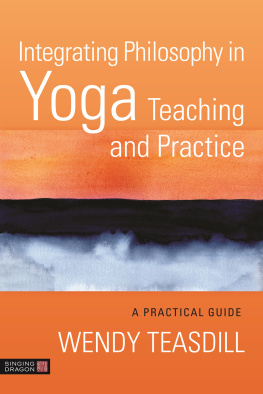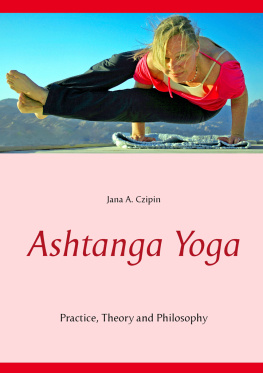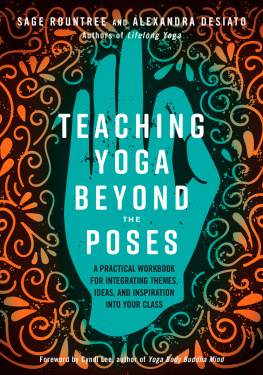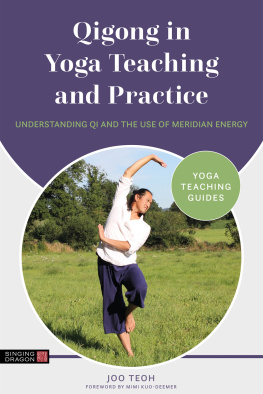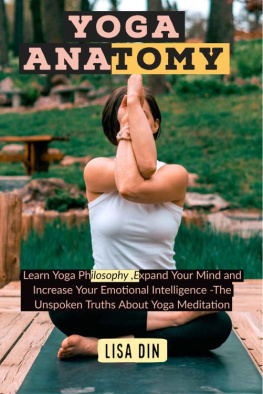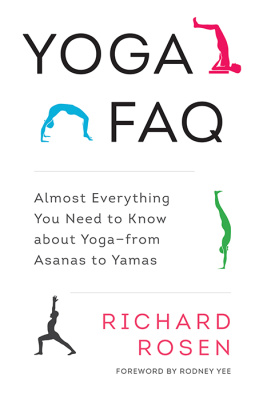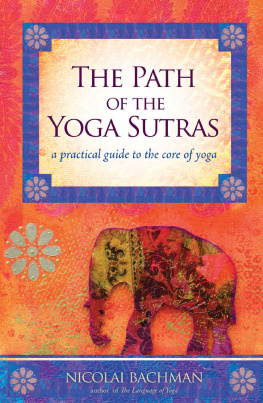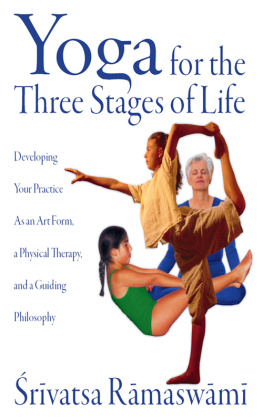Wendy Teasdill - Integrating Philosophy in Yoga Teaching and Practice
Here you can read online Wendy Teasdill - Integrating Philosophy in Yoga Teaching and Practice full text of the book (entire story) in english for free. Download pdf and epub, get meaning, cover and reviews about this ebook. year: 2020, publisher: Jessica Kingsley Publishers, genre: Religion. Description of the work, (preface) as well as reviews are available. Best literature library LitArk.com created for fans of good reading and offers a wide selection of genres:
Romance novel
Science fiction
Adventure
Detective
Science
History
Home and family
Prose
Art
Politics
Computer
Non-fiction
Religion
Business
Children
Humor
Choose a favorite category and find really read worthwhile books. Enjoy immersion in the world of imagination, feel the emotions of the characters or learn something new for yourself, make an fascinating discovery.
- Book:Integrating Philosophy in Yoga Teaching and Practice
- Author:
- Publisher:Jessica Kingsley Publishers
- Genre:
- Year:2020
- Rating:5 / 5
- Favourites:Add to favourites
- Your mark:
- 100
- 1
- 2
- 3
- 4
- 5
Integrating Philosophy in Yoga Teaching and Practice: summary, description and annotation
We offer to read an annotation, description, summary or preface (depends on what the author of the book "Integrating Philosophy in Yoga Teaching and Practice" wrote himself). If you haven't found the necessary information about the book — write in the comments, we will try to find it.
Integrating Philosophy in Yoga Teaching and Practice — read online for free the complete book (whole text) full work
Below is the text of the book, divided by pages. System saving the place of the last page read, allows you to conveniently read the book "Integrating Philosophy in Yoga Teaching and Practice" online for free, without having to search again every time where you left off. Put a bookmark, and you can go to the page where you finished reading at any time.
Font size:
Interval:
Bookmark:

Integrating Philosophy in Yoga Teaching and Practice
A PRACTICAL GUIDE
Wendy Teasdill

In 1978 I travelled overland to India, having just finished a degree in English literature (with sidelines in philosophy and fine art). In Pakistan I inadvertently drank dirty water and contracted hepatitis, which led to the disconcerting experience of being reduced to a pathetic shadow of my usual energetic self. After a few weeks I was able to take trains around southern India, following a list of sacred sites and temples recommended by a random man I met at the railway station in Panjim. And so at Shravanabelagola I found myself at the white marble feet of a lofty statue of a naked man with leaves carved up his legs, arms and torso.
I knew nothing not even the way back to my hotel, it transpired. But when a south Indian priest robed in red cracked open a coconut and poured the milk over the great white stone feet while chanting a mantra in a high, elongated voice, I was transported on a beam of pure sound to somewhere else. Where I went is indescribable and, though I eventually found my way back to my hotel, I never really returned.
Some months later I arrived back in the UK, irrevocably changed. The bridge between expectations and their realization had broken and the gap between here and there was a depressing abyss. I was fortuitously introduced to a strong Pranayama practice (4:4:16:8 aimed at healing the liver) and pranic healing by a friends mother, and reconstruction of the bridge began. Re-energized, working temporarily as a lifeguard, I spent all my breaks reading books on pranic healing by Swami Ramacharaka and started to attend a weekly Iyengar adult evening class.
The yoga classes brought everything together. The teacher was John Hawkins a gentle, considerate teacher who had studied with Mr Iyengar on his yearly visits to the UK in the early seventies. My attire was standard for the time: a blue nylon leotard with brilliant pink cotton leggings. I bought Light on Yoga and quickly got the idea: there is no yoga but Iyengar Yoga. I loved it. It was my lifesaver, framework, my life. I infused every posture with Prana and practised daily on a Sri Lankan grass mat.
I made bridges of my own, qualified to teach English as a Foreign Language, and proceeded to travel for many years as far away as I could, always carrying translations of the Bhagavad Gita and the Upanishads, practising yoga wherever I was. After about ten years and many travels abroad (but always returning to Johns class when I was back in the UK), I told John I was going to Pune to study with Mr Iyengar. John warned me that Iyengars teaching style was a little harsher than his own, and advised me not to make yoga my whole life. Meanwhile I harboured a secret wish: one day, maybe, I could become a yoga teacher instead of an English teacher even though my mother (a maths teacher) told me that teaching yoga was not a proper job.
Hindsight, as we all know, is a marvellous thing. Now I know that the great white marble statue was of Bahubali, known as Gometashwara, the Jain who fought with his brother for his right to the throne and then renounced the right, allowing his brother to rule in his stead while he devoted himself to an extreme renunciate practice (tapas). His practice took the form of standing in Tadasana for many years in the forest. Rooted to the spot, divested of clothes, the creepers were allowed to wind around his body, and, according to the ascetic resolutions outlined in the early Jain text of the Sthanangasutra, he couldnt even scratch himself. Carved in 983 AD , it remains, at seventeen metres high, one of the worlds tallest monoliths.
If I were to stand at those marble feet today, my mind would construct a thousand commentaries: the creepers are perfectly symmetrical how masculine, to impose order even on the supposed spontaneous spirals of nature. If that was a woman standing there especially if she was in her first trimester she would have fallen horizontal centuries ago with low blood pressure. And how about my habit of seeing the statues come to life in the twilight between waking and sleeping? There would be no mystery in what Gometashwara got up to: the ultimate renunciate would just be standing still, burning up his karma in the hope of opening a one-way passage to liberation.
I went to Pune and practised yoga with B.K.S. Iyengar. He was supposedly retired but his son Prashant had broken his leg, so in swooped the worlds greatest yogi. On the morning of his seventieth birthday he appeared in the practice room, vibrant with Prana, and I could see the blue lights of pure energy flashing from him. It was true he was severe, angry and brutal as well as sensitive, sublime and divine. During that first couple of months I learnt much from him and his daughter Gita, including being introduced to the Yoga Sutras of Patanjali, and returned half a dozen times over the years.
I semi-settled on Lamma Island in Hong Kong, using it as a base to gather funds by teaching English at the British Council, teaching yoga for hours on end to my friends on Sundays. In the early days there was no charge for the yoga it was my pleasure. My earnings from teaching English were used to travel for up to a year at a time in Tibet, Nepal and India. Back in Hong Kong there were people who wanted to do yoga but didnt know how, so I started teaching on Power Station Beach for hours and hours and began actually charging them.
The belief that there was no yoga but Iyengar Yoga was shaken when I met Bradley and became pregnant in 1992. At first it was disconcerting to be throwing up every time I attempted a downward dog, but I eventually found the reason in Gitas Gem for Women : it was the position of the placenta. In the beginning I did yoga on the beach every day, and, after all those years of Iyengar Yoga, started to make it my own: with the waves forming a gentle back-track, there was no option but to spiral, just like the creepers aspiring around Gometashwaras body. There was no need to do downward dog: I took two black dogs with me who stretched, sprawled and dug enthusiastic holes in the sand while I followed the hormonal dictates. It was not only Iona who was born from those sessions, but a whole new approach to yoga.
We returned to the UK, I joined the British Wheel of Yoga and we had two more daughters. At the British Wheel of Yoga, there is a system but no guru, and no one prescriptive way of practising and teaching. Nowadays I train teachers and have supported my family for over twenty years in this improper job. We can draw upon all traditions and it is up to us if we want to follow a guru or not: as long as a practice is safe, appropriate and well managed, it is valid. There are many definitions of yoga, and at the heart of each one lies a sincere practice which leads, sooner or later, to self-realization. Whether that is a state of liberation or integration will depend upon the nature of the path taken: one unifying factor is the development of detachment from mundane matters.
The last time I was in Pune was for Mr Iyengars ninetieth birthday in 2008. I retain respect for the Iyengar family, their passionate austerity and their attention to detail. However different it may appear, my whole asana practice every finger placement is grounded in their tuition. I also accept that every hairs breadth of deviation from their teachings wins me another million years of damnation. No matter.
Now I know that Yogi Ramacharaka was actually a Yorkshire man and that yoga is an ever-evolving beast, elegantly prowling the many ways up the mountain. Acadaemia necessarily rests on the written record, but our interpretation is flexible and the silence before and after the written word most eloquent. In 326 BC , after invading Persia, Alexander the Great had a go at India, where he witnessed a group of gymnosophists in different positions sitting or lying down naked in the full heat of the sun for a whole days mortification at a time. Descriptions resemble what we recognize as asanas, and these men were tapasvins, or renunciates, cultivating an inner fire. Were they yogis?
Font size:
Interval:
Bookmark:
Similar books «Integrating Philosophy in Yoga Teaching and Practice»
Look at similar books to Integrating Philosophy in Yoga Teaching and Practice. We have selected literature similar in name and meaning in the hope of providing readers with more options to find new, interesting, not yet read works.
Discussion, reviews of the book Integrating Philosophy in Yoga Teaching and Practice and just readers' own opinions. Leave your comments, write what you think about the work, its meaning or the main characters. Specify what exactly you liked and what you didn't like, and why you think so.

